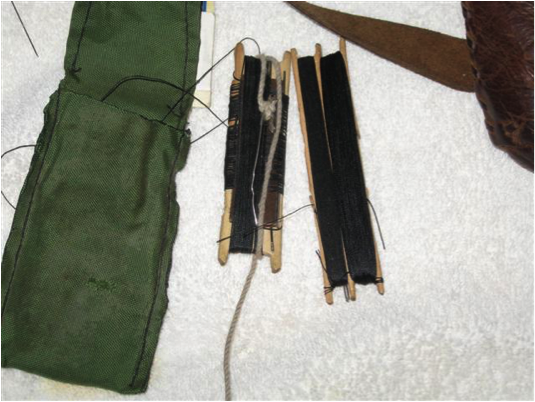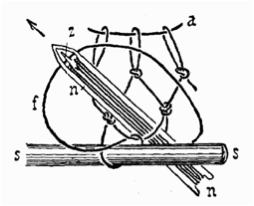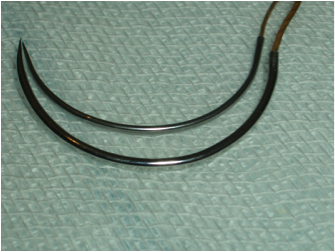SEWING KIT
(cut from the tools section of Dorene’s working doc on 2-16-2019, and not yet edited by Dorene)
I usually carry a little folder with needles and thread as a sewing kit. It’s made of two pieces of plastic with notches cut in the sides. The front plastic is shorter than the back one, and there’s a piece of leather in between.

Oliver’s sewing kit and accessories (brown beeswax, stick of clear hot melt glue, custom thimble, tape measure, and carrying case). Image from the collection of Dorene Cameron Schiro
I can stick a needle in the end of the leather, bring the thread down, wrap it around and around the notches on each side, and pull the end into a cut in one side to keep it from unwinding.
I have three or four needles—some straight, some glovers’ needles [needles with thicker triangular tips that act as awls] already threaded in the kit. I carry several of them so that I don’t have to thread a needle with cold fingers if I’m outside and need to mend a dog harness or whatever.
In the image you can see the ends of more extra needles sticking out of the end of the kit. These extra needles are not threaded.
The brown thread in the picture is shoemaker’s thread. The black thread is strong nylon. I got it from a dealer in Fairbanks who sold sewing machines. It’s very strong, though it frays easily.
The thimble has been cut in half lengthwise, and a piece of leather forms the other half. I wanted something small that would fit down in the pouch.
The brownish blob above the thimble is beeswax. Sometimes I wax my thread—if it frays, for instance. I like to put a little more beeswax on it when I’m using it double. I also use waxed dental floss for thread.
To the left you can see the cloth holster for the whole kit. That green flap folds over and is held shut with a rubber band.
I usually carry extra thread or fine nylon line wound around another piece of plastic in the kit. If I have to make a shelter, I use it to tie sticks together.
I also carry some handmade small net needles. They make it easy to work with fine line. It’s amazing how much small string or even heavy nylon thread they will hold.

Net needles wound with various kinds of thread. Image from the collection of Dorene Cameron Schiro
One of the net needles has two channels, one wound with very strong nylon thread, and the other a finer nylon thread that I use with small diameter needles. That is my extra supply. There is a lot of thread on that double-channel net needle. The heavy nylon thread is hard to use, but it’s strong. I’ve used it to tie thatch onto poles.

A net needle in use. The piece of wood at bottom is a gauge that determines the size of the net openings. (Image credit 10)
Often I don’t have a first aid kit with me, so I also carry a curved suture needle in my kit. Some suture needles come with a thread already fastened into the end, and when you’ve used that up, you discard the whole thing. You can also buy ones more like glovers’ needles, with an eye.

Commercial ready-made suture needles. (Image credit 11)
You can use a long hair from somebody’s head in an emergency if you have to sew up yourself or a dog. If you have to sew a serious wound, you need to leave one end of the wound a little bit open to allow for drainage.
If I need to sew up a dog, it’s usually because of a dogfight.
Once a neighbor lady came to my place with a dog. She had been walking with the dog beside her, and swinging her arm with a sharp single-bit axe in her hand. She accidentally split open the dog’s face. The wound was 3 inches long and went all the way down to the bone.
I felt inside the cut to see if the bone was damaged. It didn’t seem to be, so we sewed it up. It did get infected, but my neighbor’s husband had some antibiotics. Eventually the dog recovered.
Another time these same neighbors were helping me with a cache. They had used my double-bit axe and left it in a piece of wood with one blade sticking up. That’s something that I don’t do. The lady fell and cut a long gash across the base of her thumb.
We tried to sew that up, but the skin on her hand was just too tough for the needles that we had. We eventually pulled the wound together with butterfly bandages, and it healed all right.